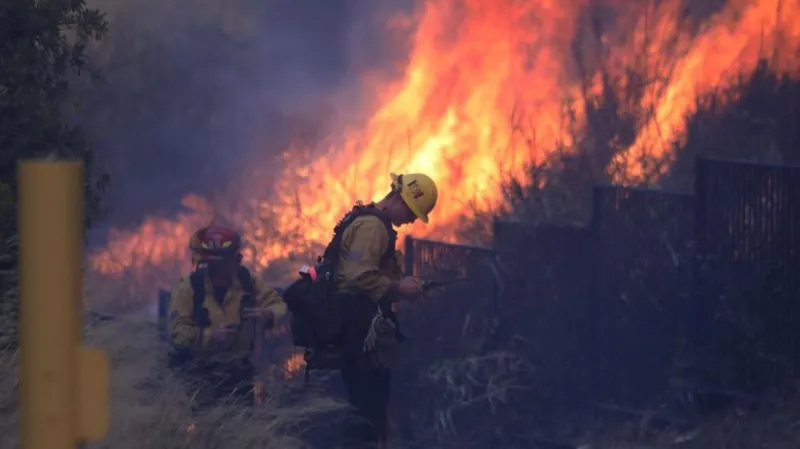
High Winds, Lack Of Rain & Climate Change Stoking California Fires: High winds and a lack of rainfall are some of the main factors driving the severity and frequency of wildfires in Southern California. Experts believe that climate change is altering the background conditions of these fires, making them more likely to occur and harder to control.
The climate’s warming trend has amplified the number of days when conditions are conducive to wildfires, contributing to a longer fire season and more extreme fire events in the region. California, a state already prone to wildfires, has become particularly vulnerable to these fires due to prolonged periods of drought, rising temperatures, and increasingly erratic weather patterns.
Wildfires in California are not a new phenomenon, but their intensity and frequency have increased in recent decades. Experts point to several key factors influencing the fires, with the most immediate causes being the combination of high winds and dry conditions. Southern California, in particular, experiences seasonal wind events, such as the Santa Ana winds, which occur primarily in the fall.
These winds, which can reach speeds of 60 to 70 miles per hour, blow from the interior of the state toward the coast. While these winds are natural, they are now exacerbated by drier-than-usual conditions, creating the ideal circumstances for wildfires to ignite and spread rapidly. The winds are drying out the land, further increasing the risk of fires. As the fires ignite, the winds blow embers across vast areas, allowing fires to travel quickly and unpredictably.
According to experts, while the strongest winds are typically observed at the beginning of the fire event, the driest vegetation usually occurs toward the end, meaning that these fires can last longer and spread further. For instance, recent fire outbreaks in Southern California have been much larger and more destructive than past fires, with flames spreading rapidly across regions that are typically protected by firebreaks or natural barriers.
One of the most concerning effects of the Santa Ana winds and dry conditions is the shifting of fire zones. Historically, wildfires in California were concentrated in mountainous areas, where rugged terrain and less-populated regions kept the fires at bay. However, with these new fire events, the flames have been sweeping down into the valleys and spreading into more densely populated areas. This shift poses a greater risk to people, homes, and infrastructure.
The change in fire behavior is concerning because it increases the potential for loss of life and property damage, especially in urban areas. Daniel Swain, a climate researcher from UCLA, pointed out that the increasing frequency of high winds and dry conditions means that fires are not only more difficult to control but are also more likely to start in areas with more ignition sources.
For example, power lines, which are often blamed for sparking wildfires, are more common in these lower-lying, more populated areas. In turn, this makes it harder to implement public safety measures like preemptive power shutdowns, which have become a regular precaution in fire-prone areas. As a result, there is a growing concern about the safety of residents in these fire zones, as the ability to take preventive action is being eroded by the changing climate.
The impact of climate change on the frequency and intensity of wildfires is undeniable. Rising temperatures, reduced rainfall, and shifting weather patterns are all contributing to more favorable conditions for fire outbreaks. This is particularly evident in California, where researchers have noted that the state is experiencing more “fire weather” days, which are days when conditions are prime for wildfires.
These days are marked by low humidity, strong winds, and high temperatures—all of which are intensified by climate change. As global temperatures continue to rise, fire seasons in California are lasting longer, and the number of fire weather days is steadily increasing. This has turned what was once a seasonal risk into a year-round problem.
California’s vulnerability is compounded by its geography. The state is dominated by mountainous terrain, which makes fire suppression efforts more challenging. When a fire breaks out in the steep, rugged hillsides of the state, it is often difficult for firefighting crews to access the area. This is further exacerbated by California’s natural vegetation, which consists of fire-prone shrubs and dry grasslands.
These plants act as fuel for fires, helping them to spread quickly across the landscape. Compounding these natural factors is the longer-term issue of drought. California has suffered from recurring droughts over the past several decades, and the drought cycle has been prolonged in recent years. The most severe drought in the state’s history ended only two years ago, and since then, wet conditions have caused an explosive growth of shrubs and trees.
While this rapid growth of vegetation might initially seem beneficial, it has created an abundance of fuel for wildfires. With the arrival of a hot summer and dry autumn, this excess fuel combined with the lack of rain has created the perfect conditions for fires to ignite. According to researchers, the hotter conditions caused by climate change increase the likelihood of wildfires by raising the frequency of dry spells and by reducing the overall moisture in vegetation.
The drying out of plant life—especially shrubs, grasses, and trees—creates a situation where wildfires can spread rapidly. The combination of these changing conditions has made California more susceptible to fires, which are not only burning more intensely but also for longer periods. While California has faced significant fire seasons in the past, the current situation is more extreme than ever.
As Professor Stefan Doerr, the Director of the Centre for Wildfire Research at Swansea University, stated, “While fires are common and natural in this region, California has seen some of the most significant increases in the length and extremity of the fire weather season globally in recent decades, driven largely by climate change.” However, it is still difficult to attribute any specific fire directly to climate change.
It is only through detailed attribution analysis that researchers can more accurately measure how climate change has specifically influenced the severity of individual fire outbreaks. One of the most urgent challenges in addressing the increasing wildfire threat in California is the lack of long-term solutions. The state has been proactive in implementing fire prevention measures, such as controlled burns, firebreaks, and evacuation plans, but these measures are not enough to mitigate the impacts of a warming climate.
With the continued rise in temperatures and shifting weather patterns, it is clear that California’s wildfire problem is only going to get worse unless more comprehensive action is taken. Climate change has made it more difficult to predict when and where fires will start, making it harder to prepare and respond effectively. In conclusion, high winds and a lack of rainfall are significant contributors to the growing wildfire threat in Southern California, but the overarching factor is the changing climate.
As temperatures rise and weather patterns shift, fire seasons in the state are becoming longer and more extreme. The impacts of these changes are far-reaching, affecting not only the natural environment but also human lives and infrastructure. Researchers have warned that this situation is likely to worsen in the coming years unless action is taken to address the underlying drivers of climate change. The increasing frequency of extreme fire weather events is a stark reminder of the urgent need for climate action to prevent further devastation.

